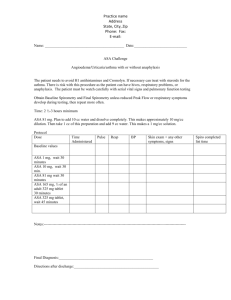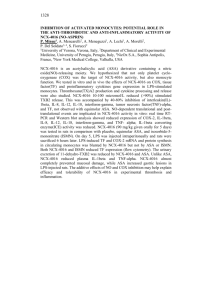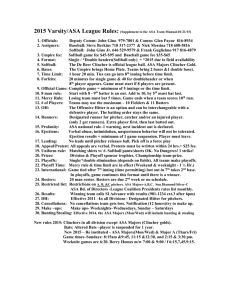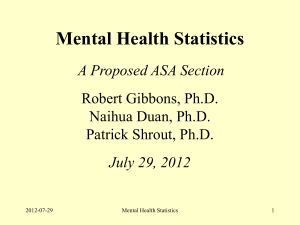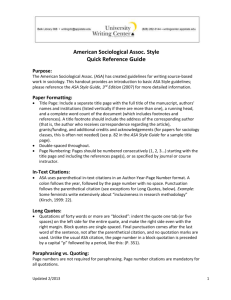ASA Physical Status Classification System
advertisement
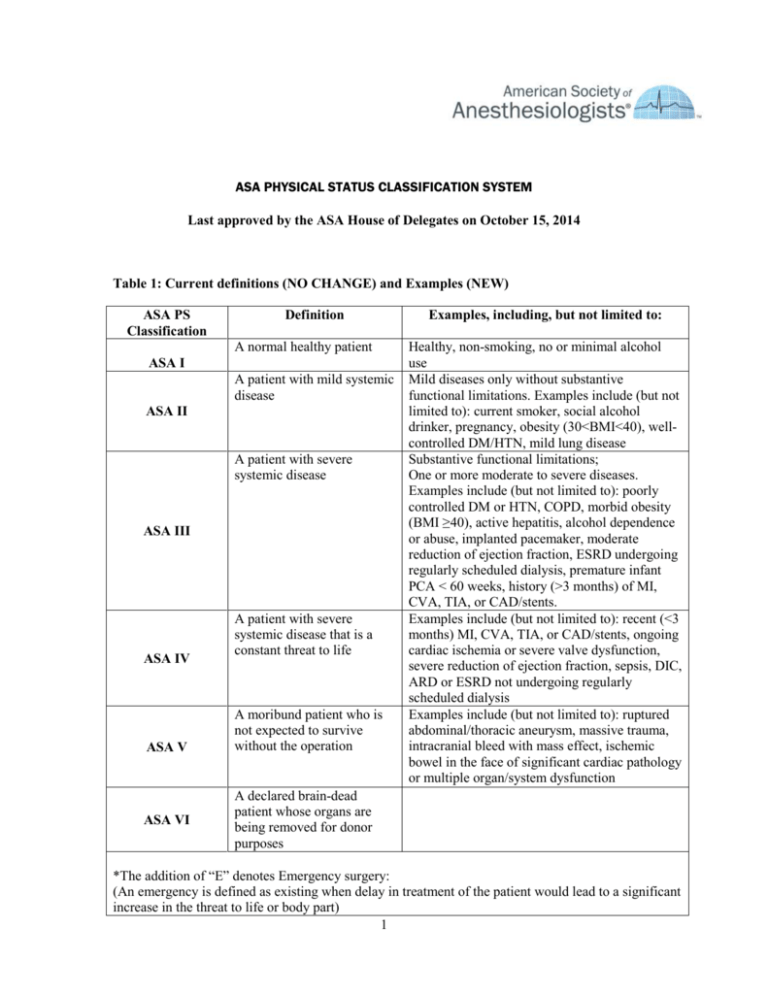
ASA PHYSICAL STATUS CLASSIFICATION SYSTEM Last approved by the ASA House of Delegates on October 15, 2014 Table 1: Current definitions (NO CHANGE) and Examples (NEW) ASA PS Classification Definition A normal healthy patient ASA I A patient with mild systemic disease ASA II A patient with severe systemic disease ASA III ASA IV ASA V ASA VI A patient with severe systemic disease that is a constant threat to life A moribund patient who is not expected to survive without the operation Examples, including, but not limited to: Healthy, non-smoking, no or minimal alcohol use Mild diseases only without substantive functional limitations. Examples include (but not limited to): current smoker, social alcohol drinker, pregnancy, obesity (30<BMI<40), wellcontrolled DM/HTN, mild lung disease Substantive functional limitations; One or more moderate to severe diseases. Examples include (but not limited to): poorly controlled DM or HTN, COPD, morbid obesity (BMI ≥40), active hepatitis, alcohol dependence or abuse, implanted pacemaker, moderate reduction of ejection fraction, ESRD undergoing regularly scheduled dialysis, premature infant PCA < 60 weeks, history (>3 months) of MI, CVA, TIA, or CAD/stents. Examples include (but not limited to): recent (<3 months) MI, CVA, TIA, or CAD/stents, ongoing cardiac ischemia or severe valve dysfunction, severe reduction of ejection fraction, sepsis, DIC, ARD or ESRD not undergoing regularly scheduled dialysis Examples include (but not limited to): ruptured abdominal/thoracic aneurysm, massive trauma, intracranial bleed with mass effect, ischemic bowel in the face of significant cardiac pathology or multiple organ/system dysfunction A declared brain-dead patient whose organs are being removed for donor purposes *The addition of “E” denotes Emergency surgery: (An emergency is defined as existing when delay in treatment of the patient would lead to a significant increase in the threat to life or body part) 1 1 2 3 4 5 6 7 8 9 10 11 12 13 14 15 16 17 18 19 20 21 22 23 24 25 26 27 28 29 30 31 32 33 34 35 36 37 38 39 40 41 Appendix 1 References related to use of the ASA PS Classification System 1. Guidelines for the use of Sedasys by non-anesthesia trained proceduralist and nurse. http://www.sedasys.com/ 2. American College of Surgeons’ proposed guidelines for care of pediatric surgical patients. Journal of the American College of Surgeons, 2014;218:479-48 3. Guidelines for local anesthesia cases in a major academic center. “Monitoring patients receiving local anesthesia”, MGH, Perioperative Nursing, OR L. 16 4. Office Based Procedure guidelines https://phpmm.org/Portals/79/WebFiles/Provider%20Manual%20Updates/Clinical%20Guidel ines/MQIC%202009%20Office-Based%20Surgery%20Guideline.pdf 5. Preoperative testing guidelines. http://www.choosingwisely.org/doctor-patient-lists/americansociety-of-anesthesiologists/ Appendix 2 Selected References Addressing Inter-Rater Reliability of the ASA PS Classification System 1. Owens WD, Felts JA, et al. ASA physical status classifications: A study of consistency of ratings. Anesthesiology. 1978;49:239–43 (Editorial by Keats AS. The ASA Classification of Physical Status – A Recapitulation. Anesthesiology 1978;49:233-6) 2. Haynes SR, Lawler PG. An assessment of the consistency of ASA physical status classification allocation. Anaesthesia. 1995;50:195-9 3. Mak PH, Campbell RC et al. The ASA physical status classification: inter-observer consistency. Anaesth Intensive Care 2002;30:633-40 4. Aronson WL, McAuliffe MS, Miller K. Variability in the American Society of Anesthesiologists Physical Status Classification Scale. AANA J. 2003;71:265–74 5. Jacqueline R, Malvivya S et al. An assessment of interrater reliability of the ASA physical status classification in pediatric surgical patients. Paediatr Anaesth 2006;16:928-31 6. Burgoyne LL, Smeltzer MP. How well do pediatric anesthesiologists agree when assigning ASA physical status classifications to their patients. Paediatr Anaesth 2007;17:956-62 7. Bernard PA, Makin CE et al. Variability of ASA physical status class assignment among pediatric sedation practitioners. Int J Adolesc Med Health 2009;21:213-20 8. Cuvillon P, Nouvellon E et al. American Society of Anesthesiologists' physical status system: a multicentre Francophone study to analyse reasons for classification disagreement. Eur J Anaesthesiol 2011;28:742-7 9. McMillan M, Brearley J. Assessment of the variation in American Society of Anesthesiologists Physical Status Classification assignment in small animal anaesthesia. Vet Anaesth Analg. 2013 May;40(3):229-36 10. Sankar A, Johnson SR et al. Reliability of the American Society of Anesthesiologists physical status scale in clinical practice. Br J Anaesth 2014 Apr 11 (epub ahead of print) 2
